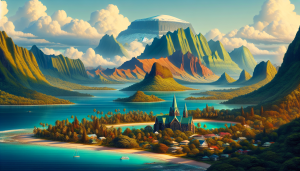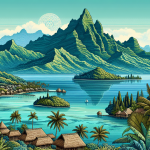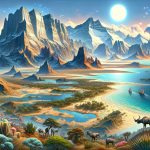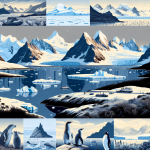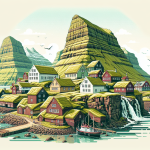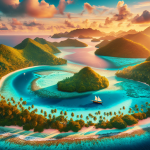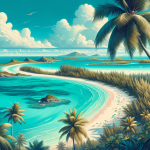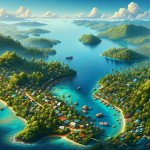Exploring the Enigmatic Archipelago of Wallis and Futuna
Wallis and Futuna, a French overseas collectivity nestled in the South Pacific Ocean, is a hidden gem waiting to be discovered by intrepid travelers. This archipelago, comprising three main volcanic tropical islands and numerous tiny islets, offers a unique blend of cultural richness, natural beauty, and a serene way of life that is hard to find elsewhere. With Wallis Island (Uvea) to the north and the Futuna Islands (including Alofi) to the south, it spans an area of about 142 square kilometers, making it one of the world’s lesser-known, yet profoundly captivating destinations. In this comprehensive guide, we will delve into what makes Wallis and Futuna an extraordinary place to visit, from its fascinating history and vibrant culture to its stunning landscapes and untouched beaches.
Discovering Wallis and Futuna
Historical Background
Wallis and Futuna boast a rich history that dates back over a millennium. The islands were first inhabited by Polynesians, with Wallis being settled around 800 AD. The islands were later discovered by European explorers in the 17th century. Wallis Island was named after the British explorer Samuel Wallis, who visited in 1767. The French influence began in the 19th century, and in 1961, Wallis and Futuna became a French overseas territory. This blend of Polynesian and European heritage is evident in the islands’ architecture, traditions, and way of life.
Cultural Richness
The cultural landscape of Wallis and Futuna is a vibrant tapestry woven from centuries of Polynesian traditions interspersed with French influences. The residents, known as Wallisians and Futunians, are predominantly Roman Catholic, and religious festivals play a significant role in their lives. Visitors will often witness traditional dances, music, and ceremonies that reflect the islands’ deep-seated cultural heritage. The local languages, Wallisian and Futunan, are widely spoken alongside French, adding another layer to the islands’ rich cultural mosaic.
Natural Beauty
Wallis and Futuna are renowned for their stunning natural landscapes. Wallis Island is characterized by its lush greenery, crater lakes, and pristine beaches. Lake Lalolalo, a volcanic crater lake, is one of the island’s must-see natural wonders. Meanwhile, the Futuna Islands offer rugged terrain, with Mount Puke (the highest peak) providing breathtaking views. The surrounding coral reefs and clear waters make the archipelago a paradise for snorkeling, diving, and other water activities.
Attractions and Activities
While Wallis and Futuna may not be as commercially developed as other tourist destinations, this is part of their charm. The islands offer a range of activities that allow visitors to connect with nature and the local culture.
Exploring Wallis Island
- Mata-Utu Cathedral: This iconic cathedral, built in the 19th century, stands as a symbol of the island’s religious heritage.
- Talietumu: An ancient archaeological site, Talietumu is a testament to the island’s pre-European history, featuring stone walls and platforms.
- Lake Lalolalo: A perfect spot for nature lovers, this crater lake is surrounded by dense forest and offers a tranquil retreat.
Futuna Islands Adventure
- Mount Puke: Hiking to the summit of Mount Puke is a rewarding experience, offering panoramic views of the island and the ocean beyond.
- Alofi Island: This uninhabited island is ideal for a day trip, with its untouched beaches and crystal-clear waters perfect for snorkeling.
- Traditional Villages: Visiting the local villages provides insight into the traditional way of life, with opportunities to see traditional crafts and taste local cuisine.
Practical Information for Travelers
Getting to Wallis and Futuna can be an adventure in itself, as the islands are relatively remote. Most visitors arrive via flights from New Caledonia or Fiji. Once on the islands, transportation options are limited, with rental cars and scooters being the most common means of getting around.
Accommodations range from guesthouses to small hotels, providing a comfortable base for exploring the islands. It is advisable to book accommodations in advance, especially during the peak tourist season.
Conclusion
Wallis and Futuna offer a unique travel experience that combines cultural depth, natural beauty, and a sense of tranquility that is increasingly rare in today’s fast-paced world. Whether you’re exploring ancient archaeological sites, hiking to volcanic peaks, or simply relaxing on a secluded beach, the islands provide an escape from the ordinary. For those willing to venture off the beaten path, Wallis and Futuna promise an unforgettable journey filled with discovery and wonder.
Related Places to Visit
If Wallis and Futuna have piqued your interest, consider exploring other remote destinations in the Pacific, such as:
- New Caledonia: Another French territory, offering a blend of Melanesian and French cultures, with stunning lagoons and diverse marine life.
- Fiji: Known for its vibrant culture, beautiful beaches, and excellent diving spots.
- Samoa: Rich in Polynesian culture, with lush landscapes and welcoming locals.
For more information on travel destinations and tips, visit Lonely Planet.
By embracing the spirit of adventure and curiosity, you can uncover the hidden treasures of Wallis and Futuna, a destination that promises to leave a lasting impression on any traveler lucky enough to discover its charms.
